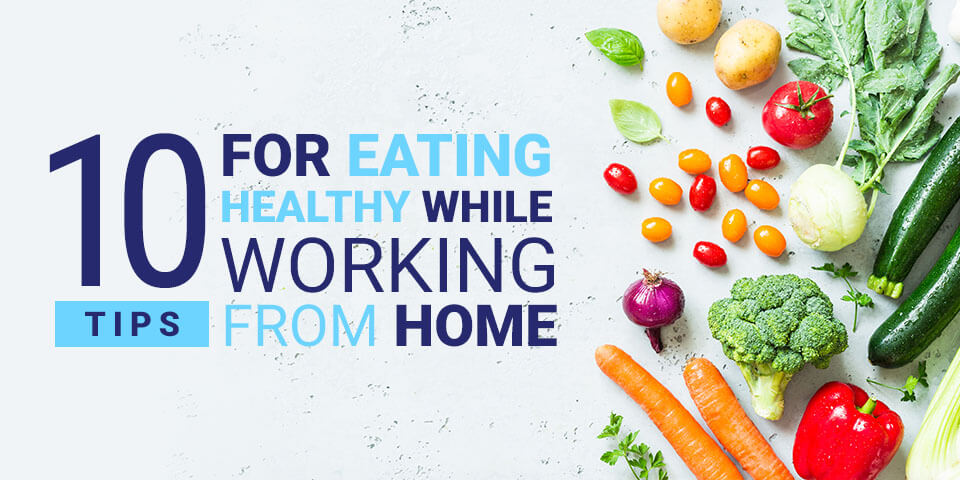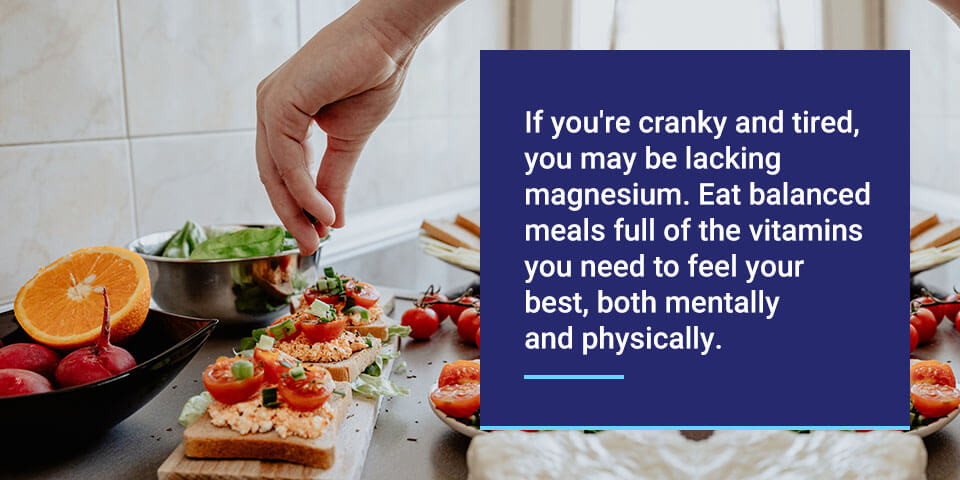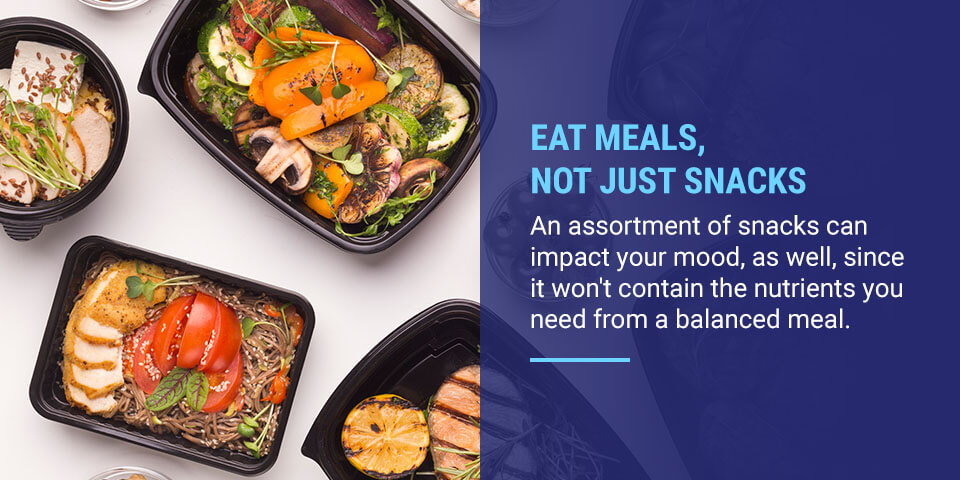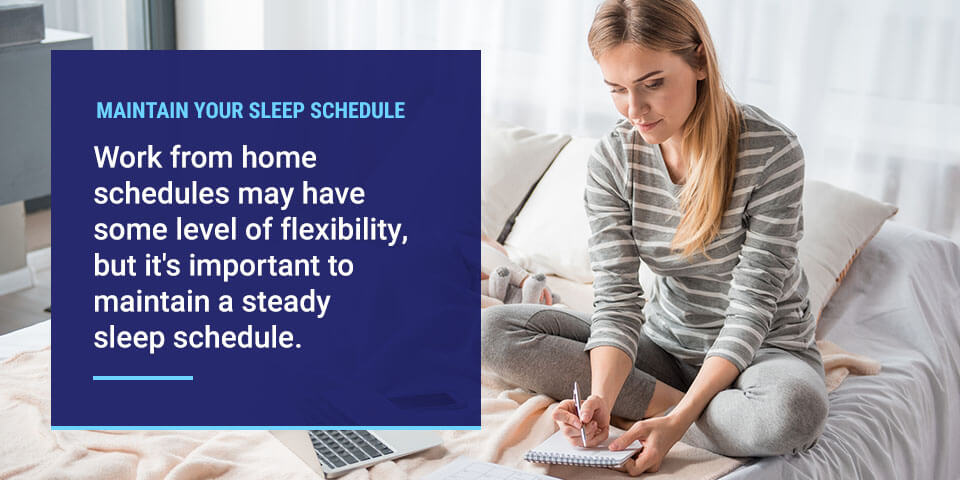10 Tips for Eating Healthy While Working From Home
10 Tips for Eating Healthy While Working From Home
Posted on: August 8, 2023 in Nutrition
Working from home forces you to develop a different routine than working in an office, especially when it comes to mealtime. Whether you’ve recently been working remotely or have been a remote employee for a while, it’s a great time to learn how to eat healthy at home.
In this guide, we’ll discuss 10 tips for eating healthy while working from home, plus extra advice on healthy eating habits for kids and seniors. Being at home doesn’t mean your healthy routine has to go out the window. Follow the advice below to rebuild or kick-start your healthy habits.
Tips for Eating Healthy While Working From Home
When your home becomes your office, that includes your kitchen. You have access to everything in your fridge and pantry for meals and snack time. With so many options available, it’s easy to fall into poor eating habits. To avoid this, follow these 10 simple tips:
1. Don’t Work in the Kitchen
One of the biggest temptations for eating while working is the easy access to food. If you’re working in the kitchen, you may find excuses to get up and grab a snack. While small, healthy snacks are good if you need them, eating all day won’t improve your health. If you can, set up your desk or work area in an office, bedroom or living room instead of your kitchen or dining room.
Many people also reach for food when they’re stressed, bored or rewarding themselves. Working away from the kitchen can help you avoid heading to the fridge when work gets slow or difficult or when you complete a project. Once you’re working in a different room of your house, try to resist the temptation to go to the kitchen when those moods strike, unless it’s time for breakfast, lunch or a snack.
2. Don’t Eat at Your Desk
When you work from home, it can be tempting to get things done while you eat. However, you should have meals away from your desk to avoid working while eating. If you have a dedicated mealtime and eat away from your desk, you’re more likely to:
- Avoid overeating: Multitasking as you eat can lead to distractions. You may not notice you’re getting full, and if you have too much food on your plate, you may end up eating it all as you’re working.
- Feel more satisfied: When you pay attention to your food as you eat, you’re more likely to notice when you feel full, and that helps you feel satisfied with your meal. You won’t be going back for seconds or snacks in a bit if you focus as you eat and feel satisfied.
- Develop a routine: A day at a workplace is often structured with set mealtimes or breaks, but when you work from home, you may have more flexibility. Try to follow a routine to maintain structure in your workday, even if you’re at home.
- Get up and moving more: When you eat at your workspace, you may have gathered some food earlier and munched on it throughout the day. Getting up to prepare a meal gets you on your feet, which is helpful even if it’s for a bit.
- Make healthier choices: You could be more likely to choose healthier meals if you eat away from your work setup. Eating at a table encourages you to choose healthy meals that may be too messy or inconvenient to eat at your desk.
Designated space and time to eat will help you form healthy eating habits at home and encourage you to focus on your work. Multitasking is difficult for everyone, and if you’re trying to eat while replying to emails or working on other projects, you may be compromising your ability to focus and produce good work.
3. Recognize Your Hunger Signs
If you find it difficult to take time away from your work to eat, you’re not alone. But one way to make sure you avoid overeating and fatigue due to hunger is recognizing when you’re hungry and making time to eat. Some common hunger signs include feeling:
- Tired
- Less alert
- Less productive
- Irritable
Certain feelings may represent not only hunger but also the need for certain nutrients since food is essential for mental and physical health. If you’re feeling foggy, you may need more calories. If you’re cranky and tired, you may be lacking magnesium. Eat balanced meals full of the vitamins you need to feel your best, both mentally and physically.
Don’t have any particular hunger signs? Put yourself on an eating schedule and set reminders or alarms, so you know when to take a quick break to eat. You’ll avoid going too long without eating and discovering that you do have hunger signs.
4. Do Some Meal Prep
When you’re working, it can be difficult or impossible to take the time to cook a meal. Avoid the temptation to rely on pre-prepared meals, as those can lack the nutrition you need to stay healthy. Make your own meals to control the portions and ingredients for results that are healthy and tasty.
Working from home opens you up to plenty of meal possibilities, but the endless options can get overwhelming. In those cases, meal prep is useful. Meal prep involves taking time on the weekend or the night before you work to set up convenient yet healthy meals. Meal prep makes quicker work of getting a meal together once it’s time to eat. You’ll only have to reheat or assemble the pieces and enjoy. Here are some tips on how to keep eating healthy with meal prep:
- Research healthy recipes and create a grocery list for the upcoming weeks.
- Prepare beforehand with cooking rice or proteins, making sauces, cutting veggies and more.
- Portion food as you prep to make it easier to prepare when you’re ready to eat.
- Keep your prepped meals in a visible spot in the fridge, so you reach for them instead of unhealthy options.
Label your meals with the date you made them, and be sure to follow food safety guidelines for ingredients you’re cooking beforehand, especially meat. If you cook meat over the weekend, make sure you consume it earlier in the week rather than leaving it for long. Many meal prep dishes focus on pre-cooking or prepping less risky vegetables and grains to make lunches like these:
- Rice bowls
- Salads
- Wraps
- Whole grain pasta dishes
- One-pan roasted meals
There is an abundance of healthy meal prep ideas, whether you’re looking for light lunches or filling dinners to get you through the week. Try new recipes to keep your lunches interesting, and experiment with healthy alternatives to see what you or your family enjoy.
5. Eat Meals, Not Just Snacks
Avoid snacking all day and calling that your meal. Even a handful of healthy snacks throughout your workday may not be enough to fuel you, keep you on schedule and help you develop healthy habits. An assortment of snacks can impact your mood, as well, since it won’t contain the nutrients you need from a balanced meal, like:
- Protein
- Healthy fats
- Fiber
- Various vitamins from fruits and vegetables
Remember those essential nutrients when you create your meals, and try to get a bit of everything on your plate instead of grabbing a handful of snacks whenever you feel a little hungry.
6. Don’t Skip Breakfast
Your work from home routine may involve waking up and getting right to work instead of performing your usual morning habits. For many, those habits include eating breakfast, but if you’re skipping that in favor of diving into your day, you may want to rethink your routine. Breakfast is a vital part of your morning routine because it gives you the fuel you need to start your day.
Even if you don’t want to eat right when you wake up, you can still enjoy a small breakfast a few hours before your scheduled lunchtime. Keep it simple with fruit, or go for healthy options with oatmeal or homemade granola bars.
7. Snack Smart
It’s hard to avoid snacking, and sometimes, it gives us the boost of energy we need to get through the day. Between lunch and dinner is an especially popular time to snack since it gives you that final burst to finish your work and cook dinner. Follow a few tips to make healthier snack time choices:
- Don’t buy junk food or have it in the house.
- If you do have junk food in your kitchen, keep it hidden in cabinets to avoid temptation.
- Put healthy snack options in front of the unhealthy ones, so you’re more likely to choose them.
- Prepare healthy snacks when you do your meal prep for the week.
Healthy Snacks While Working From Home
If you do get a craving for sweet or salty foods, go with healthy snack alternatives. Instead of candy, have a smoothie, frozen grapes or other fruits. Instead of chips, try lightly salted nuts or unsalted whole-wheat pretzels. Try to cut out the refined sugars and added salt whenever you snack, and try to avoid snacking at your desk.
8. Portion Your Food
When you eat lunch at your workplace, you bring a specific amount from home to eat. At home, you don’t have that same level of control. You can grab a bag of snacks or head back to the fridge for seconds, and that could lead to unhealthy results. Manage how much you eat and avoid overeating by portioning out your food with these tips:
- Follow serving sizes on the packaging.
- Keep in mind your specific dietary needs.
- Consider what else you’re eating that day.
- Use smaller plates or bowls.
Everyone’s hunger and dietary needs are different, so remember that serving sizes may not reflect how much you want or need to eat. Instead of eating more of the same thing, mix in different foods that have the essential nutrients and vitamins you need.
9. Avoid Too Much Caffeine
When you’re home, it can be tempting to brew a pot of coffee and drink from it all day, but drinking too much coffee can have unfortunate side effects. Ironically, some of those effects will impact your alertness, concentration and how awake you feel, with common issues such as:
- Headaches
- Anxiety
- Problems with digestion
- Fatigue
To avoid those issues, limit yourself to a certain number of cups of coffee per day. If you feel like you need caffeine to get through the day, try tea instead.
10. Stay Hydrated
Swap your other beverages for water to make healthier choices. Get a reusable water bottle for your desk and have it filled every morning to encourage you to sip water throughout the day. You’ll consume less caffeine and sugar if you focus on drinking water and stay appropriately hydrated.
How much water you need per day depends on your activity level and what type of foods you eat throughout the day. Listen to your body and drink when you feel thirsty. Take occasional sips from your water bottle rather than drinking a whole bottle in one sitting to maintain hydration.
Eating Healthy Tips for Children
When kids are home from school, it can be challenging to continue healthy eating at home. Try to keep your children’s diets on track with the following tips:
1. Create a Routine
A scheduled breakfast, lunch and dinner time is great for kids to develop healthy eating habits and avoid over-snacking. It also lets you manage your time, so you can cook meals for them and gather together to eat a meal based on your schedule. If you already have a mealtime schedule when your kids are at school, don’t stray too far from that so they can maintain their routine.
2. Start a Food Journal
Start food journals for everyone in your family or just your kids. Older kids can fill out journals on their own with a bit of prompting, but younger children may need more guidance. What you log in a food journal depends on your needs and concerns, but the options include:
- How much water you drink
- What fruit and vegetables you’ve eaten
- Healthy recipes you’d like to try
- Other specific health concerns, like sugar or vitamin intake
You’ll also find convenient apps that let you track how much you’ve eaten in a day and the nutritional information of what you’ve eaten. Certain apps even let you track exercise and set goals for daily intake of calories, vitamins and other nutritional aspects.
3. Make Fun Snacks and Meals
Part of getting kids involved in healthy eating is showing them the fun side of food. Mold their healthy eating habits for the future by starting at a young age, and use these tips to get children excited about eating healthily:
- Get creative: For younger kids, create fun meals and snacks that encourage them to eat. You can also do the classic trick of hiding fruit and vegetables in certain recipes to give them the vitamins and nutrients they need.
- Give them options: Kids like to have choices, and giving them a say in what they eat can help develop healthy eating habits. Give them healthy options and explain how they are nutritious and delicious. You can even offer a variety of toppings for healthy meals like salads that kids can choose from to customize their meals.
- Have them help: Certain tasks in the kitchen are perfect for kids to help with. You get to work together, and they get to learn valuable cooking skills that relate to healthy eating. Even young kids can help with washing produce or doing other simple and safe tasks. Make sure everyone washes their hands before, during and after meal prep to keep everything sanitary, especially with little kids who may eat ingredients or touch their faces while helping.
Healthy Eating at Home Tips for Seniors
Kids and adults have certain dietary and health needs, and many of those considerations also apply to seniors. But as we get older, we often need to adjust our diets and eating habits to account for what our bodies require. Hopefully, you’ve been building healthy eating habits since childhood, but if you haven’t, there’s no better time to start focusing on healthy eating at home with these tips:
- Have more liquids in your diet: As we age, we can have less of a sense of thirst. Drink water throughout the day or other liquids to maintain healthy hydration.
- Minimize your salt intake: People of any age should avoid excess salt, but seniors especially should focus on consuming less. Don’t season your food with salt, and instead, use herbs and other salt-free spices to add flavor to your meals.
- Reduce sugar intake: Just as you should consume less salt, do the same with sugar. Naturally sweet foods, like fruits, are fine to satisfy your sweet tooth, but other foods, like baked goods and desserts, have added refined sugar that isn’t healthy for anyone.
Make sure that, as a senior, you’re getting all the essential vitamins you need, as well, including:
- Calcium for bone health
- Vitamin D to help absorb calcium
- Magnesium to produce bone and protein
- Vitamin B12 for blood and nerve cell growth
- Vitamin B6 to produce energy
- Probiotics to promote digestion
- Zinc to fight infections and inflammation
Other Tips for Staying Healthy at Home
Knowing how to eat healthy at home is a great start to getting on-track with beneficial habits, but staying healthy isn’t only about what you eat. In addition to eating healthy, be sure to:
- Move around: For some, working from home means that the most movement you get during your workday is going from your bed to your desk. Set aside time before, during or after your workday for a quick walk. If you don’t have convenient areas or weather for walking where you live, try at-home exercise methods to get your muscles working and your heart rate up.
- Stand when you can: Some work from home tasks may allow you to stand as you get something done. If your tasks all require sitting, consider using a standing desk or raising your work station to a level you can work comfortably from while standing.
- Sit correctly: At home, you may feel more relaxed, and that could lead to sitting positions that aren’t good for your posture. Sit up straight instead of slouching or laying down, as it may reduce back pain, strain and other issues.
- Keep up with health routines: If you’re new at working from home, your routine may feel disrupted. It’s essential to stick to your normal routines but adapt them to your new at-home schedule. Take vitamins and medication when you normally would and stick to regular bathing and skin care routines. Set alarms to remind you if you’re having trouble adjusting.
- Maintain your sleep schedule: Work from home schedules may have some level of flexibility, but it’s important to maintain a steady sleep schedule. Get the amount of sleep you need to feel fully rested and try not to sleep in too late.
Kick-Start Your Health at Home With 5 Bridges Health & Fitness
Ready to launch your health and fitness transformation? At 5 Bridges Health & Fitness, we want to help you develop healthy habits and change your life. From personal trainers to group classes, everything we offer at 5 Bridges Health & Fitness is designed to help you get active, get healthy and see results. Experience our world-class yet affordable programs and fitness solutions for yourself to get the results you’re looking for.
Check out our blog for more tips on developing healthy habits, and kick-start your health with help from us at 5 Bridges Health & Fitness!










